China Evergrande Group Bundle
How Did China Evergrande Group's Competitive Landscape Lead to Its Downfall?
The story of China Evergrande Group is a cautionary tale of ambition, debt, and the volatile nature of the Chinese real estate market. From its humble beginnings in 1996, Evergrande rapidly ascended to become a real estate behemoth, fueled by aggressive expansion and a booming property sector. This rapid growth, however, masked underlying vulnerabilities that would ultimately lead to a dramatic collapse, impacting global markets. Understanding the China Evergrande Group SWOT Analysis is key to understanding its rise and fall.
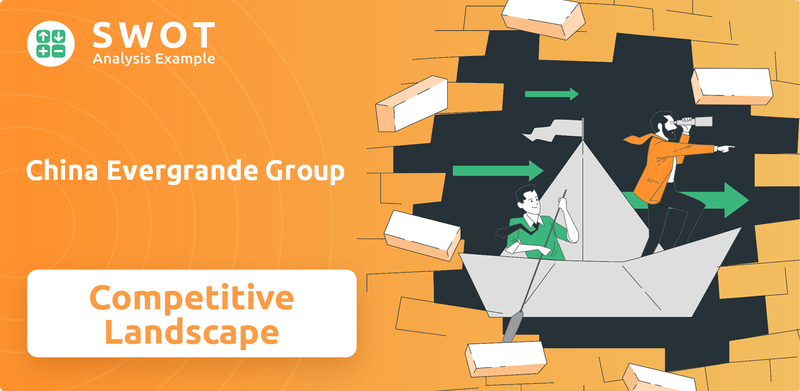
To fully grasp the magnitude of Evergrande's crisis, we must delve into its competitive landscape and analyze its Evergrande market analysis. Examining Evergrande's competitive positioning and the strategies of its Evergrande competitors, such as other Chinese property developers, provides critical insights into the challenges facing Evergrande Group's financial health. This analysis is essential for understanding the impact of Evergrande's debt crisis and the future prospects of Evergrande Group within the real estate market China.
Where Does China Evergrande Group’ Stand in the Current Market?
Prior to its financial difficulties, China Evergrande Group held a prominent position in the Chinese real estate market. The company's core operations centered on large-scale residential property development, with a focus on projects across various cities in China. Evergrande aimed to attract a wide range of consumers by offering properties at competitive prices, which helped maintain high sales volumes.
The company's value proposition revolved around providing affordable housing options, especially in second and third-tier cities. It expanded rapidly through aggressive land acquisitions and quick project turnovers. Evergrande also diversified its business by venturing into property management and new energy vehicles, although real estate remained its primary source of revenue. By 2020, Evergrande was the second-largest property developer by sales in China.
By the end of 2023, Evergrande's total liabilities reached approximately 2.437 trillion yuan (approximately $334 billion USD), highlighting the severity of its debt crisis. This situation contrasts sharply with the generally healthier financial positions of its peers, who adopted more conservative debt management strategies. The company's over-reliance on debt made its market position fragile and ultimately unsustainable.
In 2020, China Evergrande Group achieved contracted sales of 723.25 billion yuan (approximately $100 billion USD), which placed it among the top developers in China. This strong sales performance was driven by its extensive project portfolio and competitive pricing strategies. However, this success was built on a foundation of high leverage.
Evergrande had a significant geographic footprint, with projects in over 280 cities across China. The company managed more than 1,300 projects, demonstrating its widespread presence in the real estate market. This extensive reach allowed Evergrande to target a broad consumer base.
While residential property development was the core business, Evergrande diversified into property management. In 2023, property management generated 11.5 billion yuan in revenue. The company also invested in new energy vehicles, although this segment remained a smaller part of its overall revenue.
Evergrande's aggressive expansion strategy led to high debt levels, making its financial position precarious. By late 2023, the company's total liabilities were substantial, which significantly impacted its market position and future prospects. The Marketing Strategy of China Evergrande Group provides additional insights into its challenges.
Evergrande's market position was shaped by its sales performance, geographic reach, and diversification efforts. Its focus on affordable housing and competitive pricing drove sales, but its high debt levels created significant risks. The company's expansion into property management and new energy vehicles showed its diversification efforts.
- Competitive Pricing: Offering properties at competitive prices to maintain high sales volume.
- Rapid Expansion: Aggressive land acquisition and quick project turnover.
- Geographic Reach: Extensive presence across over 280 cities in China.
- Debt Burden: Over-reliance on debt, making its market position fragile.
China Evergrande Group SWOT Analysis
- Complete SWOT Breakdown
- Fully Customizable
- Editable in Excel & Word
- Professional Formatting
- Investor-Ready Format
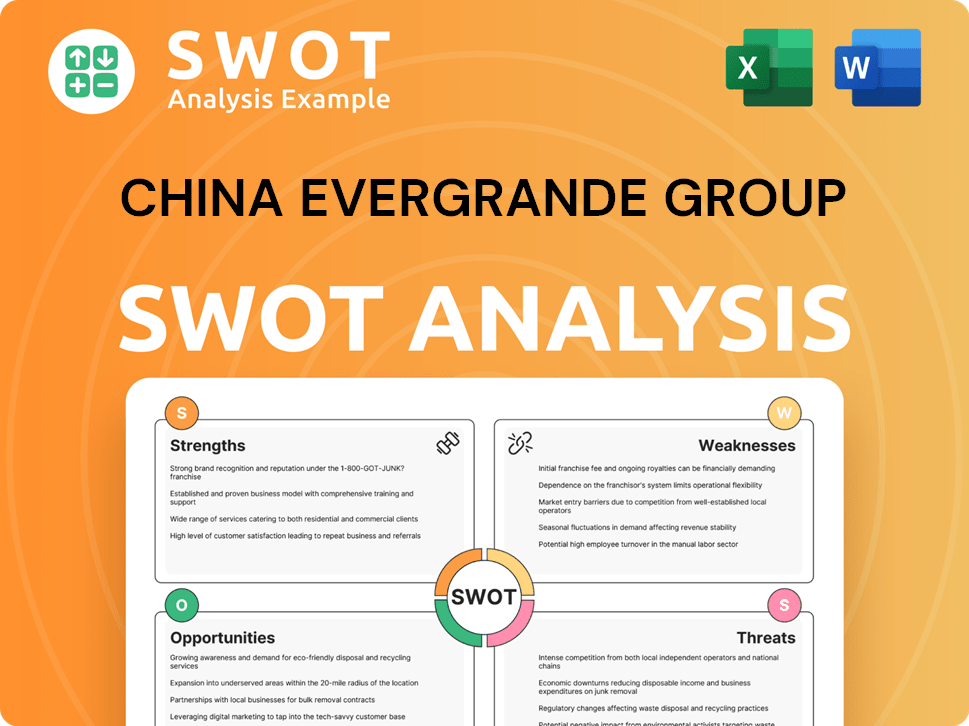
Who Are the Main Competitors Challenging China Evergrande Group?
The Owners & Shareholders of China Evergrande Group faced a highly competitive environment. The company's struggles underscored the intense rivalry within the Chinese real estate market. Understanding the competitive landscape is crucial for analyzing Evergrande's challenges and future prospects.
China Evergrande Group navigated a complex web of competitors, both direct and indirect. The real estate market in China is vast and dynamic, with numerous players vying for market share and customer attention. This environment significantly impacted Evergrande's operations and financial performance.
Evergrande's competitive positioning was constantly challenged by various factors. These included financial health, government regulations, and the strategic moves of its rivals. The company's ability to adapt to these pressures determined its survival and success.
Direct competitors included large, established property developers. These companies directly competed with Evergrande for land, projects, and customers. The competition was particularly fierce in major cities and high-growth areas.
China Vanke was a major rival, often vying for the top spot in sales. Known for its focus on quality and conservative financial management, Vanke presented a strong challenge. In 2023, Vanke's contracted sales reached approximately CNY 376.1 billion.
Country Garden, like Evergrande, pursued rapid expansion, particularly in lower-tier cities. This strategy led to direct competition for land acquisitions and customer segments. In 2023, Country Garden's contracted sales were about CNY 300.5 billion.
Poly Developments, a state-owned enterprise, leveraged its strong financial backing and access to prime land parcels. This gave them a significant advantage in the competitive landscape. Poly Developments reported contracted sales of CNY 443.1 billion in 2023.
Greenland Holdings, with its diversified business model, also competed with Evergrande. Their broader portfolio helped them withstand market fluctuations. Greenland's revenue in 2023 was approximately CNY 300 billion.
China Resources Land, another key player, often had stronger government backing and financial stability. This allowed them to compete effectively. China Resources Land's sales in 2023 reached about CNY 400 billion.
Indirect competitors and emerging trends also shaped the Evergrande competitive landscape. Smaller, regional developers, and those focusing on niche markets, added to the competitive pressure. The 'Three Red Lines' policy further intensified the challenges.
The real estate market in China is characterized by intense competition. Several factors influence the competitive dynamics among Chinese property developers, including market share, financial stability, and government regulations.
- Market Share Battles: Developers frequently compete for market share in specific cities, leading to price wars and incentives.
- Regional Developers: Smaller, regional developers with local market knowledge pose indirect competition.
- Emerging Players: Companies focusing on smart homes or sustainable development introduce innovative models.
- Regulatory Impact: The 'Three Red Lines' policy favored developers with healthier balance sheets.
- Mergers and Alliances: Consolidation efforts among smaller developers can shift competitive dynamics.
China Evergrande Group PESTLE Analysis
- Covers All 6 PESTLE Categories
- No Research Needed – Save Hours of Work
- Built by Experts, Trusted by Consultants
- Instant Download, Ready to Use
- 100% Editable, Fully Customizable
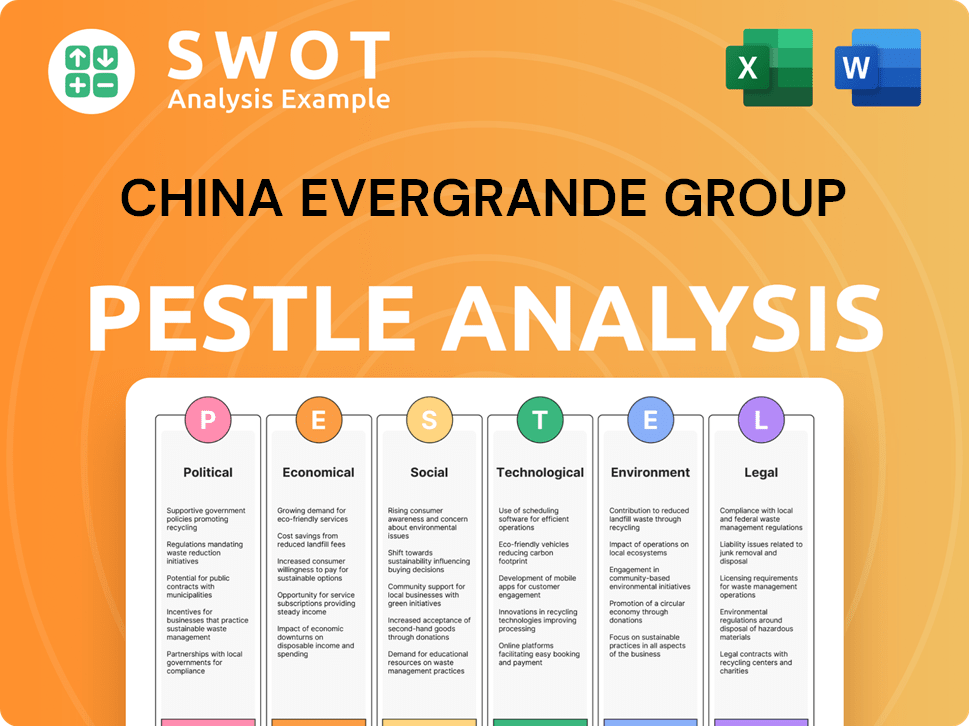
What Gives China Evergrande Group a Competitive Edge Over Its Rivals?
Prior to its financial difficulties, China Evergrande Group's competitive advantages were rooted in its aggressive land acquisition, rapid project development, and extensive geographic reach. This strategy enabled the company to amass a substantial land bank, particularly in emerging urban areas, providing a foundation for future developments. This approach also facilitated economies of scale in construction and procurement, potentially leading to cost efficiencies. For a comprehensive look at the company's current situation, consider a detailed analysis of the China Evergrande Group.
Evergrande's operational model was designed for speed, allowing for quick project launches and sales. This 'high turnover' model was critical for generating cash flow to support further expansion. The company also benefited from brand recognition, achieved through extensive marketing and a focus on delivering affordable, large-scale residential communities, which fostered customer loyalty, especially in lower-tier cities. Furthermore, its diverse portfolio, which included commercial spaces and, more recently, forays into new energy vehicles, offered some diversification, although the latter segment struggled to gain traction. The company’s rapid expansion and diverse portfolio were key elements in its strategy.
However, many of these advantages were unsustainable due to the company's heavy reliance on debt. While the rapid development model initially provided a competitive edge, it also resulted in quality control issues and significant pre-sales, creating substantial liabilities. The brand equity, once a strength, has been severely impacted by the ongoing debt crisis and numerous instances of uncompleted projects. Evergrande's advantages were largely operational and scale-driven, making them more susceptible to shifts in financing availability and regulatory changes. The talent pool, while once robust, has also been affected by the crisis, with key personnel departures.
Before the debt crisis, Evergrande's competitive edge was built on several factors. The company's ability to quickly acquire land, rapid project development, and extensive geographic reach were key. This enabled the company to build a significant land bank and achieve economies of scale.
- Aggressive Land Acquisition: Focused on securing large tracts of land, especially in emerging urban areas, for future development.
- Rapid Project Development: Utilized a standardized model to quickly launch and sell projects, generating cash flow.
- Extensive Geographic Reach: Built a presence across numerous cities, targeting a broad customer base.
- Brand Recognition: Established a brand through marketing and delivering large-scale residential communities.
China Evergrande Group Business Model Canvas
- Complete 9-Block Business Model Canvas
- Effortlessly Communicate Your Business Strategy
- Investor-Ready BMC Format
- 100% Editable and Customizable
- Clear and Structured Layout
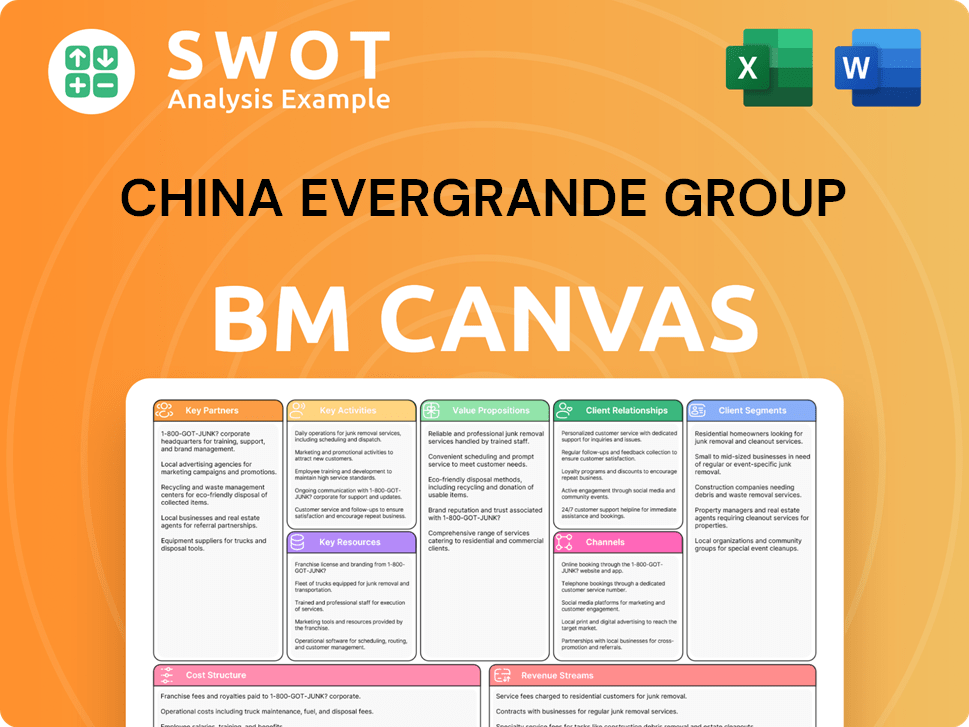
What Industry Trends Are Reshaping China Evergrande Group’s Competitive Landscape?
The Chinese real estate market is undergoing significant transformations, creating both challenges and limited opportunities for companies like China Evergrande Group. The regulatory environment, consumer preferences, and economic conditions are reshaping the competitive landscape. Understanding these dynamics is crucial for assessing the future prospects of Evergrande and its ability to navigate its current crisis.
Evergrande's competitive position is severely weakened due to its massive debt and the ongoing liquidation process. The company's future hinges on its ability to restructure its debts and complete existing projects. The broader industry, however, may see opportunities in government-backed initiatives and urban renewal projects, but Evergrande's involvement will likely be on a much smaller scale.
The Chinese real estate market faces several key trends. The government's deleveraging campaign, including the 'Three Red Lines' policy, restricts developers' access to financing. Consumer demand is shifting towards higher-quality, sustainable homes. Demographic changes and slower urbanization rates also impact housing demand. Oversupply in many regions leads to price stagnation or declines, further complicating the Evergrande competitive landscape.
China Evergrande Group faces immense challenges. The primary challenge is its massive debt and the ongoing liquidation process ordered by a Hong Kong court in January 2024. The company has a significant deficit of 636.1 billion yuan (approximately $87.8 billion USD) between its assets and liabilities. The debt crisis within the property sector continues to erode consumer confidence.
Opportunities for Evergrande are severely limited. It may participate in the real estate market on a smaller scale, focusing on specific projects or asset management. The broader industry could see opportunities in government-backed affordable housing and urban renewal projects. Developers with strong balance sheets and innovative approaches are better positioned to capitalize on these trends. For a deeper dive into their growth strategy, consider reading Growth Strategy of China Evergrande Group.
Evergrande's market position is significantly weakened by its debt crisis. Its ability to compete is severely hampered by its financial situation and the liquidation process. The company's focus is on completing existing projects and repaying creditors. The overall Evergrande market analysis reveals a bleak outlook for its competitive position.
The Chinese real estate market presents a complex environment for developers. Evergrande faces severe challenges due to its debt crisis and liquidation. The company's future prospects are limited, with opportunities primarily in completing existing projects. Developers with stronger financial health and innovative strategies are better positioned to succeed.
- The 'Three Red Lines' policy has restricted developers' access to financing.
- Consumer demand is shifting towards higher-quality homes.
- Evergrande's debt deficit is approximately $87.8 billion USD.
- The company is undergoing liquidation, impacting its competitive position.
China Evergrande Group Porter's Five Forces Analysis
- Covers All 5 Competitive Forces in Detail
- Structured for Consultants, Students, and Founders
- 100% Editable in Microsoft Word & Excel
- Instant Digital Download – Use Immediately
- Compatible with Mac & PC – Fully Unlocked
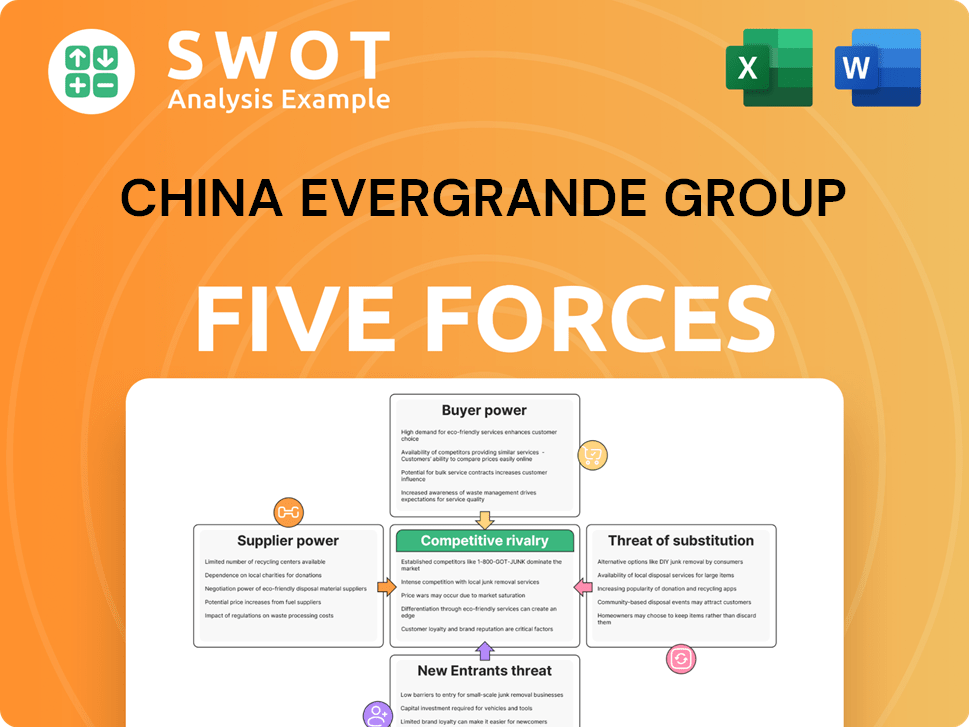
Related Blogs
- What are Mission Vision & Core Values of China Evergrande Group Company?
- What is Growth Strategy and Future Prospects of China Evergrande Group Company?
- How Does China Evergrande Group Company Work?
- What is Sales and Marketing Strategy of China Evergrande Group Company?
- What is Brief History of China Evergrande Group Company?
- Who Owns China Evergrande Group Company?
- What is Customer Demographics and Target Market of China Evergrande Group Company?
Disclaimer
All information, articles, and product details provided on this website are for general informational and educational purposes only. We do not claim any ownership over, nor do we intend to infringe upon, any trademarks, copyrights, logos, brand names, or other intellectual property mentioned or depicted on this site. Such intellectual property remains the property of its respective owners, and any references here are made solely for identification or informational purposes, without implying any affiliation, endorsement, or partnership.
We make no representations or warranties, express or implied, regarding the accuracy, completeness, or suitability of any content or products presented. Nothing on this website should be construed as legal, tax, investment, financial, medical, or other professional advice. In addition, no part of this site—including articles or product references—constitutes a solicitation, recommendation, endorsement, advertisement, or offer to buy or sell any securities, franchises, or other financial instruments, particularly in jurisdictions where such activity would be unlawful.
All content is of a general nature and may not address the specific circumstances of any individual or entity. It is not a substitute for professional advice or services. Any actions you take based on the information provided here are strictly at your own risk. You accept full responsibility for any decisions or outcomes arising from your use of this website and agree to release us from any liability in connection with your use of, or reliance upon, the content or products found herein.